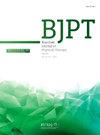Physical therapy assistance in labor: A systematic review and meta-analysis
IF 3.1
3区 医学
Q1 ORTHOPEDICS
引用次数: 0
Abstract
Background
Physical therapy assistance during labor may provide physical and emotional support to the expectant mother. Through specific techniques, physical therapists may help alleviate pain, improve mobility, and facilitate a safer and more comfortable delivery.
Objective
To perform a systematic review of the literature to assess the potential benefits and risks of physical therapy assistance during labor.
Methods
A search was conducted in the MEDLINE/PubMed, LILACS, PEDro, EMBASE, CINAHL, CENTRAL, Web of Science, and SCOPUS databases, with no restrictions on dates or language. The terms "Physical therapy assistance" and "Labor" were used. Randomized and quasi-randomized clinical trials comparing a group receiving physical therapy assistance during labor with a control group receiving standard care were included. The Cochrane tool (RoB 2.0) was used to assess the Risk of Bias, and the certainty of evidence was evaluated using the GRADE system. Quantitative analysis was performed through meta-analyses.
Results
Twelve studies involving 984 pregnant women were included. There was an increase frequency of vaginal deliveries (RR: 1.10, 95% CI 1.04, 1.17; 9 studies; I2, 2%; T2, 0.00; p = 0.42) and a reduction in cesarean sections (RR: 0.52, 95% CI 0.35, 0.76; 9 studies; I2, 0%; T2, 0.00; p = 0.65) for the physical therapy group, findings based on high-certainty evidence. There was also a reduction in the duration of the first stage of labor (MD: -99.01 min, 95% CI -153.35, -44.66; 7 studies; I2, 88%; T2, 4546.40; p = 0.00001), duration of the second stage (MD: – 11.29 min, 95% CI -18.94, -3.64; 6 studies; I2, 53%; T2, 45.01; p = 0.06) and frequence of perineal lacerations (RR: 0.49, 95% CI 0.25, 0.96; 4 studies; I2, 0%; T2, 0.00; p = 0.70) for the intervention group, findings based on moderate-certainty evidence. There was also a reduction in pain by 1.46 points on the Visual Analog Scale (MD: -1.46, 95% CI -2.52, -0.41; 7 studies; I2, 100%; T2, 1.90; p < 0.00001), findings based on low-certainty evidence, a decrease in analgesic use (RR: 0.90, 95% CI 0.83, 0.99; 2 studies; I2, 0%; T2, 0.00; p = 0.44), and maternal anxiety by 7.65 points on the State-Trait Anxiety Inventory (MD: -7.65, 95% CI -11.27, -4.03; 2 studies; I2, 88%; T2, 5.99; p = 0.005) for the intervention group. There was no difference in the other maternal and fetal outcomes.
Conclusion
Physical therapy assistance during labor provides a number of benefits to the mother.
求助全文
约1分钟内获得全文
求助全文
来源期刊
CiteScore
6.10
自引率
8.80%
发文量
53
审稿时长
74 days
期刊介绍:
The Brazilian Journal of Physical Therapy (BJPT) is the official publication of the Brazilian Society of Physical Therapy Research and Graduate Studies (ABRAPG-Ft). It publishes original research articles on topics related to the areas of physical therapy and rehabilitation sciences, including clinical, basic or applied studies on the assessment, prevention, and treatment of movement disorders.

 求助内容:
求助内容: 应助结果提醒方式:
应助结果提醒方式:


